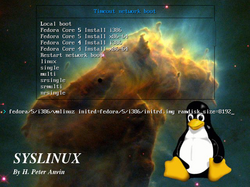Extlinux

Screenshot of SYSLINUX
|
|
| Developer(s) | H. Peter Anvin |
|---|---|
| Stable release |
6.03 / October 6, 2014
|
| Operating system | Linux |
| Type | Boot loader |
| License | GNU GPL version 2 or later |
| Website | www |
The SYSLINUX Project is a suite of lightweight master boot record (MBR) boot loaders for starting up IBM PC compatible computers with the Linux kernel. Primarily developed by H. Peter Anvin, the SYSLINUX bundle consists of several separate systems used for different purposes, including ISOLINUX, PXELINUX and EXTLINUX.
SYSLINUX is not normally used for booting full Linux installations since Linux is not normally installed on FAT filesystems. Instead, it is often used for boot or rescue floppy discs, live USBs, or other lightweight boot systems. ISOLINUX is generally used by Linux live CDs and bootable install CDs.
A minor complication is involved when booting from CD-ROM. The El Torito standard allows for booting in two different modes:
To have this choice is sometimes useful, since ISOLINUX is vulnerable to BIOS bugs; for that reason, it is handy to be able to boot using SYSLINUX. This mostly affects computers built before about 1999, and, in fact, for modern computers no emulation mode is generally the more reliable method.
The use of SYSLINUX for the creation of Live USBs is growing, though, and allowing the creation of distributions like Slax that allow users to try Linux with complete interactivity and persistent changes without needing to install it on their hard disk.
Newer ISOLINUX versions allow for creation of so-called "hybrid ISO" images, that put both CD el-torito and HDD MBR boot records into an ISO image, which lets users use a single-image as either a CD/DVD boot or USB boot.
PXELINUX is used in conjunction with a PXE-compliant ROM on a network interface controller (NIC), which establishes a PXE environment that uses or BOOTP to configure its minimalistic networking stack capable of UDP/IP networking, and then downloads a bootstrap program via . This bootstrap program loads and configures an operating system kernel according to directives that are also downloaded from the TFTP server; after the kernel is booted, it sets up its own drivers for network devices, establishes networking configuration, etc. and carries out desired tasks on its own.
...
Wikipedia
